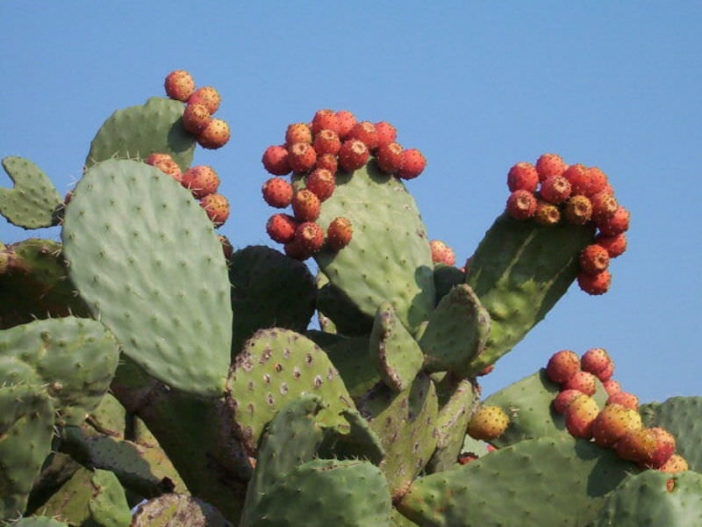Scientific Name
Opuntia ficus-indica (L.) Mill.
Common Name(s)
Indian Fig Opuntia, Indian Fig, Barbary Fig, Cactus Pear, Spineless Cactus, Prickly Pear, Mission Cactus, Mission Prickly Pear, Smooth Mountain Prickly Pear, Smooth Prickly Pear, Sweet Prickly Pear, Tuberous Prickly Pear, Tuna Cactus
Synonym(s)
Cactus ficus-indica, Cactus opuntia, Opuntia arcei, Opuntia castillae, Opuntia chinensis, Opuntia cordobensis, Opuntia ficus-barbarica, Opuntia incarnadilla, Opuntia megacantha, Opuntia vulgaris, Platyopuntia vulgaris
Scientific Classification
Family: Cactaceae
Subfamily: Opuntioideae
Tribe: Opuntieae
Genus: Opuntia
Description
Opuntia ficus-indica is a shrubby or tree-like cactus with dull green or grayish green, narrowly elliptic to ovate stem segments with small areoles that bear clusters of 3 to 6 spines. It slowly grows up to 16.5 feet (5 m) tall, often with a cylindrical trunk. The root system spreads horizontally. Stem segments (cladodes) are thick, fleshy, up to 2 feet (60 cm) long, and up to 8 inches (20 cm) wide. Flowers are bright yellow to orange and open in the late morning. They appear on 1- to 2-year-old stem segments. The floral tube is broadly cylindrical with numerous raised areoles spirally arranged, densely woolly, and filled with glochidia, occasionally bearing small spines. Fruits are ellipsoid, reddish, up to 3 inches (7.5 cm) long, with edible pulp and gray or pale tan seeds.

Hardiness
USDA hardiness zones 8a to 11b: from 10 °F (−12.2 °C) to 40 °F (+4.4 °C).
How to Grow and Care
Though the large variety of species within the Opuntia genus means different Prickly Pears may need slightly different care. All are desert cacti that need lots of sun, light, and very little water. So if you live in a hot, arid area, these plants can generally be planted outside, left alone, and enjoyed.
These cacti will grow just fine in a garden, but they can also be grown in pots. To repot, ensure the soil is dry, remove the pot and knock away the old soil. After treating any cuts with fungicide, place the cactus in a new pot and backfill it with potting soil. As with a new cutting, ensure not to water a newly repotting Prickly Pear for a brief period to avoid rotting its roots.
Opuntia can propagate either by cuttings or by seed. To propagate by cuttings, sever pads from a plant and let them dry, so the wounds heal. Then place the plants in dry soil and refrain from watering them until they begin to grow to avoid rotting them.
See more at How to Grow and Care for Opuntia.
Uses
Opuntia ficus-indica is a cactus species that has long been a domesticated crop plant important in agricultural economies throughout arid and semiarid parts of the world. It is grown primarily as a fruit crop but also for vegetable nopales and other uses. Most culinary references to the "Prickly Pear" refer to this species. The name "Tuna" is also used for this cactus's fruit and Opuntia in general.
See more at Indian Fig Opuntia: A Fruit and Vegetable Rolled Up into One Plant.
Origin
This species is native to Mexico and is widespread in Central America, Southern USA, Africa, Asia, and Southern Europe.
Links
- Back to genus Opuntia
- Succupedia: Browse succulents by Scientific Name, Common Name, Genus, Family, USDA Hardiness Zone, Origin, or cacti by Genus
Photo Gallery
Click on a photo to see a larger version.



